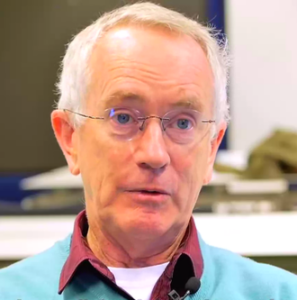Up to 20% of creatures you know will go extinct this century, according to research by Australian biologist Corey Bradshaw, Professor of Global Ecology at Flinders University, Adelaide. Then: why do top economists claim global warming over 3 degrees will cause only minor damage to the economy? From theanalysis.news podcast, Colin Anthes interviews Australian economist Steve Keen about crazy numbers from the people who advise governments, banks and business.
Listen to or download this Radio Ecoshock show in CD Quality (57 MB) or Lo-Fi (14 MB)
CORY BRADSHAW: LOSING LIFE TO EXTINCTION
“Children born today will see literally thousands of animals disappear in their lifetime, as global food webs collapse.”
That comes from new research by two established scientists. One is European Commission scientist Dr. Giovanni Strona. The other is our guest, Professor Corey Bradshaw at Flinders University. The new paper is titled “Coextinctions dominate future vertebrate losses from climate and land use change”, published December 16, 2022.

Listen to or download this 29 minute interview with Corey Bradshaw in CD Quality or Lo-Fi
I almost don’t want to discuss this loss of biodiversity. Others don’t want to hear it. We can accept huge human losses, but imagining beloved helpless creatures disappearing seems too hard to take. But here we are.
We hear a mass extinction event is developing right now. Then we go back to our lives and social media feeds. Humans do not grasp the situation well. From the new study:
“Our new research shows 10% of land animals could disappear from particular geographic areas by 2050, and almost 30% by 2100. This is more than double previous predictions. It means children born today who live to their 70s will witness literally thousands of animals disappear in their lifetime, from lizards and frogs to iconic mammals such as elephants and koalas.”
This paper find five dominant drivers in this sixth mass extinction: land-use change, overharvesting, pollution, climate change, and biological invasions. I’ll bet most people put land-use change, like burning down the Amazon, as the number one cause of extinctions. No – it’s climate change.
According to the Flinders University Press Release:
“Professor Bradshaw says despite a general appreciation that climate change is now a major driver of extinctions globally, the new analysis demonstrates clearly that we have so far underestimated its true impacts on the diversity of life on Earth. Without major changes in human society, we stand to lose much of what sustains life on our planet.”
Climate may be the dominant driver of extinctions, greater even than land-use change. But the climate stress interacts with other forces to go beyond driving particular species into extinction. A web of dependency crashes leading to unexpected and possibly misunderstood “coextinction”. This is a kind of feedback amplifier, not previously appreciated.
Many of our listeners worry about collapse and resiliency. In this new paper on the extinction crisis, the authors remind us of a 2016 paper by Strona. It suggests life systems that look strongest may actually be the most fragile. The collapse of the Soviet Union or the invincible Lehman Brothers shows that in human affairs. Strona’s work say more about surprises in the survival of animals. Strona’s important 2016 study is: “Environmental change makes robust ecological networks fragile”.
This mapping of interlocking who-eats-who could only be done for large species, land animals recognizable to humans. It sounds impossible to use the same tools for a global look at insects, and highly unlikely for microorganisms – we are far from a catalog of what exists on the tiny plane.
THE BLEAKEST TIME MAY BE IMMINENT
According to the new study by Bradshaw and Strona:
“… the greatest changes in diversity and network structure are already appreciable before 2050, highlighting how the bleakest time for natural communities might be imminent and that the next few decades will be decisive for the future of global biodiversity.”
SEE ALSO: (cited in this new paper) (Open Access)
G. Strona, C. J. A. Bradshaw, Co-extinctions annihilate planetary life during extreme environmental change. Sci. Rep. 8, 1–12 (2018).
Why does interdependency among the species seem so hard for human minds? We see the lion kill its prey and understand. We are not close to words like connectedness or webs of life. They escape us – and we lack the language and education to comprehend beyond our own limited vision…. We are also very poor at noticing absences, much less the way multiple absences can spiral into more seemingly unrelated species going extinct. This paper by Strona and Bradshaw should wake us up.
————————————
WATCH COREY BRADSHAW EXPLAIN THE NEW EXTINCTION SCIENCE
On Youtube, posted December 22, 2022
PREVIOUS COREY BRADSHAW INTERVIEWS ON RADIO ECOSHOCK
Corey Bradshaw: Stop the Ghastly Future Radio Ecoshock
Feb 3, 2021
How bad is it? Even scientists can’t grasp the reality of what is happening on this planet. 17 expert scientists poured through over 150 essential papers. Their summary is: “Underestimating the Challenges of Avoiding a Ghastly Future”. Lead author, Professor Corey Bradshaw, is from Flinders University in Australia. Co-authors include Paul and Anne Ehrlich.
AND
The Rules of Extinction
Posted on March 13, 2019
Extinction is roaming the world. In truly shocking new science, Australian biologist Corey Bradshaw finds we are closer to the brink than anyone thought.
You can watch this interview On YouTube here:
========================================
STEVE KEEN: INSANE ECONOMICS TAKES US TO RUIN
An Ecoshock listener wrote: “you have got to hear this!” We all need to hear Australian economist Steve Keen explain why corporations and governments are operating on crazy economic theories about the impacts of climate change.
I remember when the Garnaut Climate Change Review was released in Australia, back in 2008. Garnaut talked about the cost to Gross Domestic Production of a 3 to 4 degree C warming. It would be costly, but business would go on as usual he thought.
Starting in the 1990’s, Yale economist William Nordhaus started us down this dangerous track. Without a real basis in science, Nordhaus assured the world that 2 degrees C of warming would be the upper “safe” limit. The Intergovernmental Panel on Climate Change went along with that for a couple of decades, even as their own scientists raised more and more damages coming not just at 1.5 degrees C, but right now at just over 1 degree warming.
But I’ve read plenty of business-oriented reports suggesting 3 or 4 degrees C. warming is no big deal. Now we know that would be disastrous, likely a civilization-ending event. Business does not go on. Maybe humans do not go on, at least not billions of us.
Steven Keen blows up the Nordhaus theology and all the fellow-travelers who operate as climate minimizers, sometimes with fossil fuel related funding. Keen was an associate professor of economics at University of Western Sydney. He became Head of Economics at at Kingston University in London, and now does independent research. This man knows economics, and he is blowing the whistle.

Keen tells us: it’s not just corruption. It is just what economists believe. They can become a zealot for capitalism. They reject any opposition or criticism. William Nordhaus said 85%of workers will not be affected by climate because they work indoors, in controlled environments.
By their formula, 6 degrees C of warming leads to an 8% fall in GDP. Keen calls it crazy. He is working on a research project on this right now. “It’s just nonsense”.
Keen thinks only a major disaster will bring any change. Until the public is freaked out, they will not accept mandated changes to their lifestyles. Politicians cannot get too far ahead of that. To have a chance to maintain a civilization, he says we need to have some reserves, like grain stored in case of disaster, and a ration-based economy, so everyone gets a share. We need a World War Two mentality to deal with the real breakdown of nature.
In the second half of this show, you hear “Exposing Apocalyptic Economics with Steve Keen” as posted January 30, 2023 by theAnalysis.news. My thanks for permission to rebroadcast.
You can listen to Steve Keen and host Colin Anthes here.
WARMING COULD CHANGE THE WHOLE ATMOSPHERIC CIRCULATION SYSTEM
(which leads to a very different planet…)
During the interview, Keen points to a hair-raising possibility: the entire atmospheric circulation system could shift during global warming. The result would be a band of deserts around the mid-latitudes (like America, China, and Europe) as we now find in the Middle East. High amounts of rain and snow would pour down at both Poles. This has happened in the past. James Lovelock published a map of that changed planet a few years ago, after his discussions with the Hadley Institute in the UK. I called it the “map of doom”.
This is well explained in this piece from Harvard research:
“The atmosphere transports heat throughout the globe extremely well, but present-day atmospheric characteristics prevent heat from being carried directly from the equator to the poles. Currently, there are three distinct wind cells – Hadley Cells, Ferrell Cells, and Polar Cells – that divide the troposphere into regions of essentially closed wind circulations. In this arrangement, heat from the equator generally sinks around 30° latitude where the Hadley Cells end. As a result, the warmest air does not reach the poles.
If atmospheric dynamics were different, however, it is plausible that one large overturning circulation per hemisphere could exist and that wind from the low-latitudes could transport heat to the high-latitudes. As an explanation for equable climates, Brian Farrell presented this idea in 1990 and advocated that during equable climates, the Hadley Cells extended from the equator to the poles (Farrell, 1990).”
The 1990 Farrell paper is called “Equable Climate Dynamics”.
It says:
“Present climate is now known to represent one regime among others including glacial climates such as characterized recent intervals of the Pleistocene and the much warmer equable climates of the Eocene and Cretaceous.”
You can follow up with this 2014 Open Access paper: “Weakening of the global atmospheric circulation with global warming”.
========================================
Thank you to everyone who keeps Radio Ecoshock on the air with your donations. You can help with either a one-time donation or pay a little every month. All that is easy to set up here. There is no big foundation or source of grants behind this show. It’s me and you.
That is all the time we have this week. I’m Alex Smith. Keep thinking, keep trying – and thank you for caring about this world – all of it!
James Hansen’s latest (Jan 2023) demonstrates an excess of 1.5C temperature increase in 2024. Yes, you read that right, we will already break the proposed “limit” as told by the world’s most foremost climate expert.
By now, we know that more “warnings” from scientific experts will not accomplish much. Even the unfolding reality caused by deadly climate change costing billions of dollars per year has failed to change the trajectory to extinction.
Personally, I remain as pessimistic as ever that humanity will simply fail to respond adequately, in time, and at some near-future point, will belatedly and finally realize this fact as death piles up all over the planet.
Politics, science, capitalism, corporate conglomerates have all failed us miserably. Empty promises, rhetoric, failed commitments, endless meetings and deferred “plans” have all added up over the years to almost nothing.
Optimism requires meaningful hope, but what is meaningful about lies and empty promises and repeated failures? There is a terrible truth to all of this that we have yet to understand.
Of course you are correct in your hard-hitting comment.
What “response” (it’s far too late to even contemplate one now) could humanity have done in our lifetime?
There is no form of political or social governance that even have remotely begun the process of self-policing the species.
Who would have shot each and every one of all the corporate or state-corporate forces massing to operate the rigs and extraction trucks?